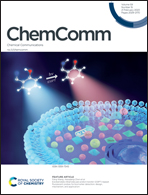Reduction chemistry yields stable and soluble divalent lanthanide tris(pyrazolyl)borate complexes†
Abstract
Reduction of the heteroleptic Ln(III) precursors [Ln(Tp)2(OTf)] (Tp = hydrotris(1-pyrazolyl)borate; OTf = triflate) with either an aluminyl(I) anion or KC8 yielded the adduct-free homoleptic Ln(II) complexes dimeric 1-Eu [{Eu(Tp)(μ-κ1:η5-Tp)}2] and monomeric 1-Yb [Yb(Tp)2]. Complexes 1-Ln have good solubility and stability in both non-coordinating and coordinating solvents. Reaction of 1-Ln with 2 Ph3PO yielded 1-Ln(OPPh3)2. All complexes are intensely coloured and 1-Eu is photoluminescent. The electronic absorption data show the 4f–5d electronic transitions in Ln(II). Single-crystal X-ray diffraction data reveal first μ-κ1:η5-coordination mode of the unsubstituted Tp ligand to lanthanides in 1-Eu.

- This article is part of the themed collection: 2023 Pioneering Investigators


 Please wait while we load your content...
Please wait while we load your content...